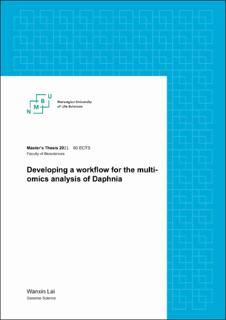| dc.contributor.advisor | Hvidsten, Torgeir Rhoden | |
| dc.contributor.advisor | Tollefsen, Knut-Erik | |
| dc.contributor.author | Lai, Wanxin | |
| dc.date.accessioned | 2022-02-21T11:56:07Z | |
| dc.date.available | 2022-02-21T11:56:07Z | |
| dc.date.issued | 2021 | |
| dc.identifier.uri | https://hdl.handle.net/11250/2980478 | |
| dc.description.abstract | In the era of multi-omics, making reasonable statistical inferences through data integration is challenged by data heterogeneity, dimensionality constraints, and data harmonization. The biological system is presumed to function as a network where the physical relationships between genes (nodes) are represented by links (edges) connecting genes that interact. This thesis aims to develop a new and efficient workflow to analyse non-model organism multi-omics data for researchers who are entangled in the biology questions by using readily available software tools. The proposed approach was applied to the transcriptome and metabolome data of Daphnia magna under various dose rates of gamma radiation.
The first part of this workflow compares and contrasts the transcriptional regulation of short-and long-term gamma radiation exposure. A group of genes which share a similar expression across different samples under the same conditions are known as modules, because they are likely to be functionally relevant. Modules were identified using WGCNA but biologically meaningful modules (significant modules) were selected through a novel approach that associates genes with significantly altered expression levels as a result of radiation (i.e. differentially expressed genes) with these candidate modules. Dynamic transcriptional regulation was modelled using transcription factor (TF) DNA binding patterns to associate TFs with expression responses captured by the modules. The biological functions of significant modules and their TF regulators were verified with functional annotations and mapped into the proposed Adverse Outcome Pathways (AOP) of D. magna, which describes the key events which contribute to fecundity reduction. The findings demonstrate that short term radiation impacts are entirely different from long term and cannot be used for long term prediction.
The second part investigates the coordination of gene expression and metabolites with differential abundances induced by different gamma dose rates and the underlying mechanisms contributing to the varying extent of the reduction in fecundity. Significant modules which belong to the same design model of dose rates were combined and annotated with new functionality. The abundance of metabolites was also modelled with the same design model. Integrated pathway enrichment analysis was performed to discover and create pathway diagrams for visualising the multi-omics output. Finally, the performance of this workflow on explaining the reduction of fecundity of D. magna, which has not been described in previous studies, has been evaluated. Combining the information from the metabolome and transcriptome data, new insights suggest that the alteration to the cell cycle is the underlying mechanism contributing to the varying reduction of fecundity under the effect of different dose rates of radiation. | en_US |
| dc.language.iso | eng | en_US |
| dc.publisher | Norwegian University of Life Sciences, Ås | en_US |
| dc.rights | Attribution-NonCommercial-NoDerivatives 4.0 Internasjonal | * |
| dc.rights.uri | http://creativecommons.org/licenses/by-nc-nd/4.0/deed.no | * |
| dc.subject | daphnia | en_US |
| dc.subject | bioinformatics | en_US |
| dc.subject | wgcna | en_US |
| dc.subject | deseq2 | en_US |
| dc.subject | metabolomics | en_US |
| dc.subject | transcriptomics | en_US |
| dc.title | Developing a workflow for the multi-omics analysis of Daphnia | en_US |
| dc.type | Master thesis | en_US |
| dc.subject.nsi | VDP::Mathematics and natural science: 400 | en_US |
| dc.description.localcode | M-GS | en_US |

